Abstract
Body-centered cubic (BCC) refractory high-entropy alloys (RHEAs) demonstrate significant potential as nuclear structural materials due to their exceptional mechanical properties and radiation tolerance. While Zr-containing RHEAs often develop multiphase structures through Zr-rich phase precipitation to enhance high-temperature mechanical performance, their irradiation response mechanisms remain poorly understood. This study investigated the microstructure evolution and radiation damage behavior in equiatomic MoNbTiVZr RHEA under Au-ion irradiation at fluences of 2 × 1015, 4 × 1015, and 1 × 1016 ions/cm2. Microstructural characterization revealed that the annealed alloy primarily consisted of near-equiatomic BCC1 phase, Zr-rich BCC2 phase, (Mo,V)Zr Laves phase, and ordered Zr2C phase. Post-irradiation analysis showed distinct defect evolution patterns: the BCC1 phase developed fine dislocation loops, while the Zr-rich BCC2 and Zr2C phases exhibited dislocation clusters and dense dislocation networks, respectively. BCC1 phase exhibited the most pronounced irradiation hardening corresponding to its fine, dispersed dislocation loop characteristics. Phase separation induced by Zr precipitation reduced chemical complexity, accelerating irradiation defect evolution. These findings demonstrated that Zr-rich phase precipitation detrimentally impacted the radiation resistance of BCC-structured RHEAs, suggesting that single-phase stability should be prioritized in nuclear material design.
1. Introduction
In recent years, high-entropy alloys (HEAs) have emerged as promising nuclear structural materials, particularly under extreme conditions such as high temperatures and high irradiation damage, due to their superior high-temperature mechanical properties, corrosion resistance, and irradiation resistance [1,2,3,4,5]. These superior properties originate from four core characteristics: lattice distortion, sluggish diffusion kinetics, high configurational entropy, and cocktail effects arising from atomic size mismatches and chemical dissimilarities among constituent elements [6,7]. Among various HEA systems, refractory HEAs (RHEAs) with body-centered cubic (BCC) structures have drawn particular attention for nuclear applications, demonstrating superior resistance to irradiation-induced hardening and swelling compared to conventional alloys and other HEA types [8,9,10]. On the one hand, the inherent irradiation tolerance of BCC-structured RHEAs stems from their low stacking ratio, which facilitate the accommodation of irradiation-induced defects. On the other hand, severe lattice distortion in BCC-structured RHEAs broadens vacancy migration energy, enhancing the recombination of irradiation defects [11]. Furthermore, their high melting points (>2000 °C) ensure excellent microstructural stability and mechanical integrity at elevated temperatures [4,12].
The irradiation resistance of RHEAs is governed by multiple interdependent factors, with chemical composition playing a pivotal role in determining defect evolution mechanisms [4,5,13,14,15]. While increasing elemental diversity enhances configurational entropy and solid solution strengthening, specific alloying elements can introduce unique strengthening mechanisms. Notable examples include the interstitial atomic strengthening through C doping [16], precipitation strengthening by Al addition [17], and amorphization by Be addition [18]. Zirconium has become a strategic alloying element in nuclear-grade BCC RHEAs due to its combination of low thermal neutron absorption cross-section (σthermal, 0.18 barns) and atomic size mismatch (atomic radius: 160 pm) [11,19,20]. However, Zr addition presents a critical challenge: thermodynamic instability leading to phase separation. Microstructural analyses of various Zr-containing RHEAs reveal phase decomposition patterns, including Zr-rich/Zr-depleted BCC phase segregation in TiTaNbMoZr [21], dual BCC phases with Zr precipitates in ZrNbMoTaW [22], NbTiV2Zr [23], and TaTiVZr RHEAs [24]. Although these multiphase microstructures enhance high-temperature strength through second-phase and interface, their heterogeneous response to radiation—where different phases exhibit distinct damage accumulation behaviors—may compromise overall radiation resistance [1,4,25]. Current research predominantly focuses on single-phase BCC RHEAs [5,18], leaving the radiation response of multiphase Zr-containing systems critically underexplored.
Among Zr-containing RHEAs, NbTiZr-based RHEAs have attracted much attention, owing to their relatively low values of σthermal coupled with balanced mechanical properties and irradiation resistance [11]. Recent developments in this alloy family include NbTiZrHf [26,27], NbTiZrAl [28], NbTiZrV [29], and TiZrNbMoV [30,31], where Mo and V serve as key alloying elements. Both Mo (σthermal = 2.6 barns) and V (σthermal = 5.1 barns) contribute to neutron economy while stabilizing BCC structures and enhancing high-temperature performance. When the content of Mo and V is low, these elements promote single-phase BCC microstructures as evidenced in TiZrNbMo0.3V0.3 [30], Ti2ZrNbV0.5Mo0.2 [31], and NbTiZr0.25V0.5Mo0.5 [32], where high configurational entropy suppresses phase separation. However, increasing Mo/V content beyond 20 at.% in equiatomic MoNbTiVZr RHEA triggers microstructural decomposition into dual BCC phases and (MoV)Zr Laves phase [25,30,33]. This multiphase architecture enables remarkable high-temperature strength retention (yield strength > 800 MPa at 1000 °C) through synergistic strengthening mechanisms, yet its implications for radiation resistance remain unexplored. In this paper, a multiphase equiatomic MoNbTiVZr RHEA was selected as a model material to investigate the effect of Zr-rich phase precipitation on the irradiation properties of RHEAs with BCC structure, providing fundamental insights for designing radiation-tolerant Zr-containing RHEAs.
2. Materials and Methods
Ingot for the equiatomic MoNbTiVZr RHEA was produced by vacuum arc melting and was remelted five times to ensure that the liquid alloy was mixed homogeneously before the final casting. Mo, Nb, Ti, V, and Zr lumps with a purity of more than 99.9% were used as raw materials. The actual composition of the as-prepared RHEA was Mo19.9Nb19.5Ti20.7V21.6Zr18.2 (at.%), as measured by energy dispersive spectroscopy (EDS). Then, 8 mm × 5 mm × 1 mm specimens were cut from the ingot using an electrical spark cutting machine. These specimens were annealed at 1400 °C for 12 h in a furnace under 10−3 Pa vacuum, followed by air cooling. For microstructural observation and irradiation, the specimens were first mechanically polished using diamond sandpapers and then polished with a 40 nm colloidal silica slurry using a vibratory polisher (VibroMetTM 2 Vibratory Polisher, Buehler, Lake Bluff, IL, USA) to remove residual stress from the surface.
Au-ions’ irradiations were performed using a 3 MV tandetron accelerator at Sichuan University, Chengdu, China [34]. Three fluences of 2 × 1015 ions/cm2, 4 × 1015 ions/cm2, and 1 × 1016 ions/cm2 were conducted at 200 ± 10 °C to investigate the irradiation response of MoNbTiVZr RHEA under different doses. Ion implantation was performed using a scanning model with a dose deviation of less than 1%. The energy of Au-ion was 6 MeV and the beam flux was constantly about 2 × 1015 ions/(cm2·h). The irradiation vacuum level was maintained at 1.2 × 10−5 Pa. On a first approximation, the displacement damage and Au implantation profiles were simulated using the Stopping and Range of Ions in Matter (SRIM) software (version 2013) in “Kinchin-Pease” mode. Threshold displacement energies are assumed to be 60, 60, 30, 40, 40, and 25 eV for the Mo, Nb, Ti, V, Zr, and C elements, respectively [31,35].
The crystallographic evolution of MoNbTiVZr RHEA before and after irradiation was analyzed using X-ray diffraction (XRD, DX-2700, Dandong Fangyuan, Dandong, China) with Cu Kα radiation (λ = 1.5406 Å). Microstructural characterization was performed through scanning electron microscopy (SEM, Inspect F50, Thermo Fisher Scientific, Waltham, MA, USA) equipped with energy-dispersive X-ray spectroscopy (EDS) for elemental mapping. Furthermore, transmission electron microscope (TEM, Talos F200X, FEI, Hillsboro, OR, USA) operated at 200 kV was employed to investigate radiation-induced defects and phase transformations. TEM cross-section samples containing the irradiated region were prepared via focused ion beam (FIB, Helios 5 cx, FEI, USA) technique. To minimize FIB-induced artifacts, final thinning was achieved through electrolytic flash polishing technique at −40 °C using a solution of 5 vol.% HClO4, 35 vol.% n-butanol and 60 vol.% methanol. Defect analysis was conducted under two-beam kinematical conditions using g = [011] vectors along the [001] zone axis for BCC phases. Nanoindentation tests with a Berkovich-type indenter (Nano Indenter G200, Agilent, Santa Clara, CA, USA) were performed to evaluate the irradiation induced hardening. Each phase underwent 8–10 indents for statistical reliability and the spacing between nanoindentations was greater than 10 μm when tested in the same phase.
3. Results
3.1. Pre-Irradiation Characterization
Figure 1 illustrated the microstructures of the as-cast and 1400 °C-annealed MoNbTiVZr RHEA. The as-cast alloy exhibited a distinct dendritic structure with significant compositional heterogeneity. The dendritic cores were enriched with high-melting-point elements (Mo and Nb), while the interdendritic regions were dominated by low-melting-point elements (V and Ti). Additionally, two types of secondary phases were observed in the interdendritic channels: MoV-rich particles and Zr-rich particles. After annealing at 1400 °C, XRD analysis (Figure 1g) confirmed the coexistence of two BCC phases and one Laves phase (Figure 1g). The BCC1 phase, characterized by a lattice constant of approximately 3.198 Å, exhibited the highest volume fraction, as evidenced by its intense diffraction peaks. SEM observations revealed that the annealed alloy retained its dendritic morphology, but the dendritic volume fraction increased and the MoV-rich particles dissolved completely (Figure 1h,i). EDS mapping (Figure 1j–n) demonstrated that the dendrites were depleted in Zr, while the interdendritic channels were rich in Zr and depleted in Mo and V. In addition, gray and dark particles precipitated in the channels. Table 1 lists the compositions of different phases marked in Figure 1i. The gray particles were rich in Mo, V, and Zr, whereas the dark particles consisted almost exclusively of Zr, which were retained from the as-cast state. For the annealed alloy, the volume fractions of the dendrites, channels, gray particles, and dark particles were 85%, 9%, 5%, and 1%, respectively. Combined with the XRD patterns, the dendrites, channels, and gray particles were identified as the BCC1, BCC2, and (Mo,V)Zr Laves phases, respectively. The dark Zr-rich phase was not detected by XRD due to its minimal volume fraction below the detection limit.
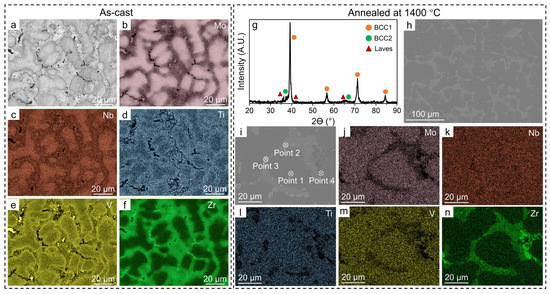
Figure 1.
Microstructure and elemental distribution of as-cast and annealed MoNbTiVZr RHEA. (a) BSE image and (b–f) EDS maps of the as-cast alloy. (g) XRD pattern, (h,i) BSE images, and (j–n) EDS maps of the annealed alloy.

Table 1.
Compositions (at.%) of the annealed MoNbTiVZr RHEA, as determined by SEM-EDS.
The microstructure of the annealed MoNbTiVZr RHEA was further characterized by TEM, as shown in Figure 2. The HAADF image revealed multiple phases with varying contrasts in the alloy matrix. TEM-EDS analysis (Figure 2) corroborated the SEM observations, showing good compositional consistency (Table 2). Selected area electron diffraction (SAED) patterns revealed distinct lattice constants for BCC1 (3.2 Å) and Zr-rich BCC2 (3.86 Å), consistent with Zr’s larger atomic radius. The Laves phase (MgCu2-type, C15) exhibited a face-centered cubic (FCC) structure with a lattice parameter of about 8.03 Å and belonged to the space group Fdm, identified as (Mo,V)Zr. Notably, the Zr-rich phase, which was enriched with C, displayed an FCC structure (Fdm) with superlattice reflections. According to the literature [36,37,38], it can be determined that this phase was Zr2C, and the superlattice reflections came from the ordered carbon vacancy structure.
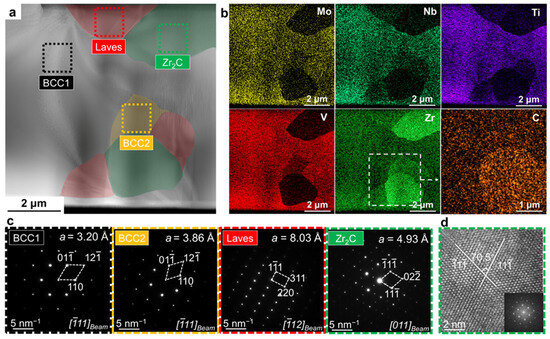
Figure 2.
TEM characterization of the MoNbTiVZr RHEA: (a) high-angle annular dark field (HAADF) image; (b) EDS mapping; (c) SAED pattern corresponding to the regions marked by rectangles in (a), with superstructure reflections in the FCC phase highlighted by red circles; (d) high-resolution TEM image of the Zr2C phase along the [011] zone axis.

Table 2.
Compositions (at.%) of the annealed MoNbTiVZr RHEA, as determined by TEM-EDS.
3.2. Irradiation Defects
Damage and ion implantation profiles of various phases in the MoNbTiVZr RHEA under a fluence of 1 × 1016 ions/cm2 were simulated using SRIM (2013) software, as illustrated in Figure 3, with detailed results summarized in Table 3. The irradiation doses increased in all phases with increasing fluences and the peak doses were about 10, 20, and 50 dpa for the fluences of 2 × 1015, 4 × 1015, and 1 × 1016 ions/cm2, respectively. Figure 4a,b displayed the XRD patterns of the MoNbTiVZr RHEA before and after irradiation at different fluences. Given the weak diffraction intensities of other phases, only the evolution of the BCC1 phase diffraction peaks was analyzed. As the irradiation fluence increased from 2 × 1015 to 1 × 1016 ions/cm2, the intensity of the {011}BCC1 peak progressively decreased. This is because the accumulation of irradiation-induced defects disrupted the periodic atomic arrangement. Furthermore, the position of the {011}BCC1 peak initially shifted to higher angle and then reversed direction with increasing fluences. According to Bragg’s law, this indicated that the lattice contracted and then expanded, as illustrated in the inset of Figure 4b. This phenomenon can be explained by the inherent lattice distortion in RHEA without irradiation [39]. Irradiation-induced stress relaxation mitigated this distortion, leading to an initial lattice contraction. However, as the fluence increased, the rising concentration of irradiation-generated Frenkel defects (interstitial atoms and vacancies) drove lattice re-expansion. A similar trend in lattice evolution has been reported in a TiZrHfVMoTa RHEA [40]. Further, selected-area electron diffraction (SAED) was employed to characterize the depth-dependent lattice variation in the BCC1 phase following 1 × 1016 ions/cm2 Au-ion irradiation (Figure 4c,d). The irradiated region (Position 1–3) exhibited significantly larger lattice constants compared to the unirradiated deeper region (Position 4), directly attributing the lattice expansion to the formation and aggregation of irradiation-induced defects. Notably, the lattice constants derived from TEM foils were systematically lower than those obtained by XRD, likely due to stress relaxation caused by the thin foil geometry.

Figure 3.
SRIM-calculated displacement damage and Au-ion implantation profiles for 6 MeV Au irradiation at 1 × 1016 ions/cm2 in (a) BCC1, (b) BCC2, and (c) Zr2C phases of the MoNbTiVZr RHEA.

Table 3.
Melting points, peak damages, and peak damage depths at different fluences for different phases.
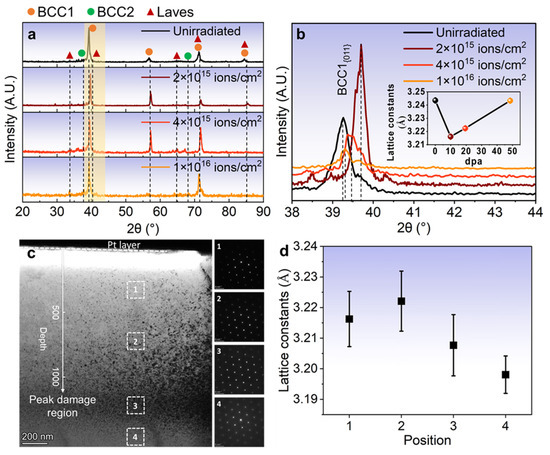
Figure 4.
Structural evolution of MoNbTiVZr RHEA under Au-ion irradiation. (a) XRD patterns comparing pristine and irradiated states. (b) Magnified view of the selected 2θ range (highlighted in yellow in (a)), with inset quantifying the lattice parameter variation in the BCC1 phase as a function of radiation damage. (c) SAED patterns and (d) statistical lattice parameters acquired at different depths in BCC1 following irradiation at 1 × 1016 ions/cm2.
Figure 5 showed the morphology of irradiation-induced defects in the BCC1 phase at different fluences. Notably, perforations were observed beneath the Pt protective layer, resulting from the complete etching of the relatively thin upper region during electropolishing. However, these perforated FIB specimens remained suitable for analysis, as the defect characterization in the peak damage region was unaffected. All defects were observed under a kinematical bright-field condition using g = 011 close to [001] or [01] zone axis. The peak damage region exhibited exclusively high-density nanoscale dislocation loops (about 10 nm diameter), with no detectable voids or precipitates. At the fluence of 2 × 1015 ions/cm2, the dislocation loops were very small and observed as black spots, confirming the low mobility. As the fluences increased from 2 × 1015 to 1 × 1016 ions/cm2, the change in the size of the dislocation loops was not remarkable, but the density increased significantly. Although direct observation of BCC2 phase damage at 2 × 1015 ions/cm2 was precluded by FIB sampling limitations, fluence-dependent evolution was evident: dislocation clusters nucleated in shallow regions and gathered within the peak damage zone (Figure 6a,b). TEM-EDS confirmed these clusters comprised pure dislocation aggregates without elemental segregation (Figure 6c).

Figure 5.
Morphology of irradiation-induced defects at the peak damage region in the BCC1 phase after irradiation to (a) 2 × 1015 ions/cm2, (b) 4 × 1015 ions/cm2, and (c) 1 × 1016 ions/cm2.
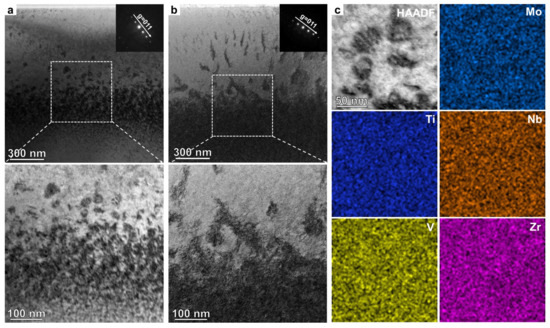
Figure 6.
Irradiation-induced defects in the BCC2 phase: (a,b) Defect morphology after irradiation to 4 × 1015 and 1 × 1016 ions/cm2; (c) HAADF image with EDS elemental maps showing dislocation clusters.
As shown in Figure 7 and Figure 8, the irradiation damage evolution in the Zr2C phase was systematically characterized. SAED analysis confirmed that both irradiated and unirradiated Zr2C phases maintained an FCC-type structure. However, a critical difference was observed in the diffraction patterns: all superlattice reflections disappeared completely under Au-ion bombardment, even at the lowest fluence (2 × 1015 ions/cm2). This phenomenon provides direct evidence for the rapid disordering of the initially ordered Zr2C structure upon irradiation. The irradiation-induced microstructural changes in Zr2C were also dominated by dislocation activity. At low fluence (2 × 1015 ions/cm2), dense dislocation loops with about 10 nm in diameter were formed. As the fluences increased, loops coarsened and interconnected. By the highest fluence (1 × 1016 ions/cm2), the damage microstructure had evolved into three-dimensional networks of entangled dislocations, indicating advanced stages of irradiation damage accumulation. Figure 9 presents a comparative analysis of irradiation responses at 1 × 1016 ions/cm2 among the three phases: the BCC1 phase maintained relatively stable damage characteristics, with small dislocation loops remaining as the dominant defect type, while the BCC2 phase showed accelerated damage evolution as larger clusters, and the Zr2C exhibited the most rapid damage progression with a fully developed dislocation network.
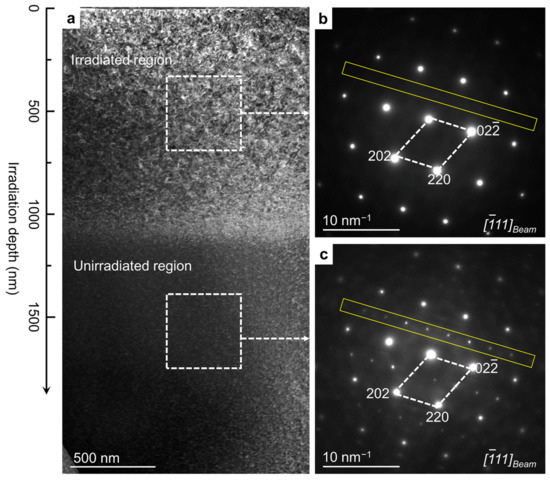
Figure 7.
Structural evolution of the Zr2C phase after irradiation to 1 × 1016 ions/cm2: (a) HAADF image; SAED patterns from (b) irradiated and (c) unirradiated regions, with superstructure reflections from carbon vacancy ordering highlighted by yellow rectangles.

Figure 8.
Dislocation evolution in the Zr2C phase after irradiation to (a) 2 × 1015 ions/cm2, (b) 4 × 1015 ions/cm2, and (c) 1 × 1016 ions/cm2.
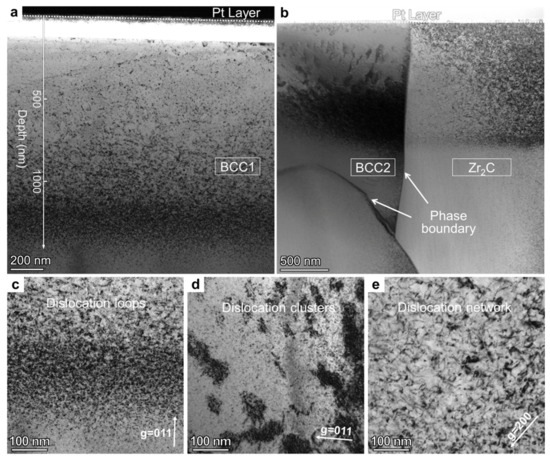
Figure 9.
TEM images of different phases in the MoNbTiVZr RHEA after irradiation at 1 × 1016 ions/cm2. (a,b) Cross-sectional views of damage layers. Irradiation-introduced dislocation defects of peak damage region for (c) BCC1, (d) BCC2, and (e) Zr2C phases.
3.3. Irradiation Hardening
Figure 10 presented the nanoindentation hardness of individual phases in the MoNbTiVZr RHEA before and after irradiation at different fluences. The indentation size effect was corrected using the Nix–Gao model [41], with summarized hardness data, incremental changes, and hardening rates provided in Table 4. It should be noted that the actual plastic deformation depth during nanoindentation typically extends up to ~10 times the indentation depth [42]. Meanwhile, the irradiated damage layer exhibits a non-uniform defect density distribution along the depth, which inevitably influences hardness measurements at different penetration depths [43,44,45]. Accordingly, in the Nix–Gao plot, the fitting was primarily performed on hardness values corresponding to the peak damage region, where the indentation depth h ranged approximately from 100 to 140 nm (i.e., h−1 between 7 and 10 μm−1). This approach guarantees that the analyzed deformation zone lies entirely within the peak damage region (1000~1400 nm in depth), as demonstrated in Figure 5. Before irradiation, the average hardnesses of the BCC1 and BCC2 phases were 7.35 and 7.86 GPa, respectively, while the Zr2C phase showed a much higher hardness of about 16.71 GPa. This extremely high intrinsic hardness originates from carbon-induced lattice distortion and strong covalent Zr-C bonding [46]. Post-irradiation hardening occurred universally across all phases, with distinct trends: BCC1 exhibited monotonic hardening, while BCC2 and Zr2C displayed initial hardening followed by softening at 1 × 1016 ions/cm2. Both the maximum hardness increment (2.13 GPa) and hardening rate (29.0%) was found in the BCC1 phase at 1× 1016 ions/cm2.
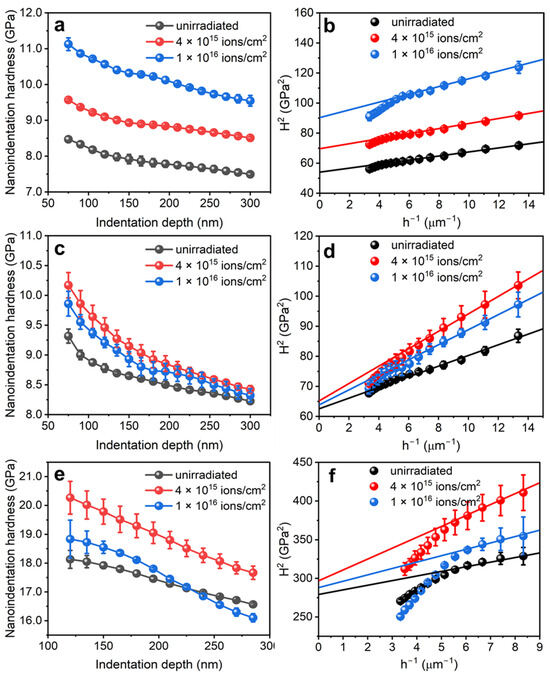
Figure 10.
(a,c,e) Nanoindentation hardness-depth profiles and (b,d,f) corresponding plots of H2 vs. h−1 plots for BCC1, BCC2, and Zr2C phases, respectively (H: hardness at depth h). Error bars represented standard deviations from multiple indentation values.

Table 4.
Average nanoindentation hardness, hardness increments, and hardening rates of different phases in the MoNbTiVZr RHEA at different fluences.
4. Discussion
4.1. Microstructure of MoNbTiVZr RHEA Before Irradiation
Phase separation is often triggered by the introduction of alloying elements with distinct structural and chemical characteristics in RHEAs. In the equimolar MoNbTiVZr RHEA, the constituent elements exhibit significant differences in melting points—for instance, Mo’s melting point is ~1200 °C higher than that of Zr. Such a large melting point disparity leads to sequential solidification during casting, where Mo solidifies first while Zr remains in the liquid phase for longer. The primary dendritic arms (e.g., Mo, Nb) reject Zr, enriching the remaining melt with Zr and ultimately resulting in Zr-rich interdendritic channels and the precipitation of Zr-rich particulate phases. Additionally, excessive Zr content contributes to its incomplete dissolution. Similar Zr precipitation phenomena are also reported in NbTiZr-V [47] and NbTiZr-Mo [48] RHEAs.
High-temperature annealing is commonly employed to eliminate casting-induced segregation in RHEAs. After annealing at 1400 °C, the dendritic phase fraction in the MoNbTiVZr RHEA increased, but dendritic segregation persisted, and Zr-rich interdendritic particles still remained. The annealed alloy consists of a dual BCC matrix, a (Mo,V)Zr Laves phase, and a Zr2C phase (Figure 1 and Figure 2). While Senkov et al. [25] did not report the formation of a Zr2C phase in the same annealed equimolar MoNbTiVZr RHEA, their BSE images reveal precipitates of similar morphology. Notably, C is not intentionally added but introduced as an unintended impurity, likely due to residual carbon contamination from the furnace during high-temperature annealing. In fact, Zr’s strong affinity for interstitial elements (C, N, O) promotes the formation of Zr-rich compounds, which is difficult to avoid [49,50]. Furthermore, the ordered carbon vacancy configuration was generated in Zr2C, which was caused by the aggregation of thermally activated vacancies during extended annealing [36,51]. In summary, the annealed equimolar MoNbTiVZr RHEA develops a multiphase structure accompanied by Zr precipitation. The irradiation response of these phases, as well as the influence of Zr segregation, is investigated. Notably, the (Mo,V)Zr Laves phase, constituting ~5 vol.% of the alloy, is a key constituent. However, the Laves phase in this system displays a unique structure and irradiation behavior, warranting further detailed analysis beyond the scope of this study. Thus, its irradiation performance will be examined separately in future work.
4.2. Microstructure Change Caused by Irradiation
After Au-ion irradiation, distinct dislocation features manifested in different phases of the MoNbTiVZr RHEA. In the BCC1 phase, irradiation-induced defects were characterized by scattered black dot-like dislocation loops (Figure 5). The size of these dislocation loops showed no significant change due to the low irradiation temperature, but their density increased significantly as the fluences increased from 2 × 1015 to 1 × 1016 ions/cm2. In contrast, large dislocation clusters instead of scattered dislocation loops appeared in the BCC2 phase (Figure 6). In general, the evolution of dislocations undergo three stages during irradiation: the aggregation of interstitials and vacancies to form dispersed dislocation loops, the growth and clustering of dislocations, and finally the coalescence of dislocation loops to form networks [18]. The BCC1 phase demonstrated superior irradiation resistance compared to the BCC2 phase, as evidenced by its slower evolution of dislocation features. Given that both phases possess disordered BCC structures, the accelerated defect evolution in the BCC2 phase can be primarily attributed to its pronounced compositional deviation, particularly the enrichment of Zr (40.5 at.%). This Zr enrichment likely promotes localized chemical ordering (e.g., Zr-Zr clustering), diminishing the hindering effect of chemical complexity and allowing defects to migrate and aggregate more rapidly within Zr-rich regions, ultimately forming dislocation clusters. Furthermore, compared to the BCC1 phase, the BCC2 phase exhibits a significant reduction in Mo and V content alongside increased Zr concentration. The depletion of Mo weakens the stabilizing effect of high-melting-point elements on the matrix, while the decrease in V reduces solid solution strengthening, collectively lowering the resistance to dislocation motion. Consequently, small, dispersed dislocation loops formed in the BCC1 phase, whereas large dislocation clusters developed in the BCC2 phase.
In contrast to the BCC matrix, the unirradiated Zr2C phase possessed an ordered vacancy structure, which was disrupted upon irradiation. As reported by Wei et al. [37], Zr0.6C containing carbon vacancies exhibited lower lattice expansion under irradiation compared to stoichiometric ZrC because the inherent carbon vacancies could act as sinks for irradiation-induced interstitial atoms. However, in the irradiated Zr2C phase, dense dislocation loops formed and initiated coalescence even at a low fluence of 2 × 1015 ions/cm2 (Figure 8a). With increasing fluence, these loops quickly grew up and unfolded into dislocation lines. Finally, the microstructure was dominated by tangled dislocation networks at 1 × 1016 ions/cm2 (Figure 8c). It can be seen that the defect morphology in the Zr2C phase evolved markedly faster than in the BCC1 and BCC2 phases with increasing dose. This suggests that the Zr2C phase with ordered carbon vacancies had a limited inhibitory effect on the growth of irradiation defects compared to the high-entropy phases. The interfaces of dispersed secondary phases usually absorb defects like vacancies and interstitials, improving irradiation resistance (for example, oxide dispersion-strengthened steels [52]). However, the Zr2C phases in the MoNbTiVZr RHEA only occupied about 1 vol.% (Figure 1) and mainly existed between dendrites. This distribution limited their ability to absorb defects. Overall, the formation of Zr-rich phases (BCC2 and Zr2C) reduced the alloy’s irradiation resistance by accelerating defect evolution.
4.3. Irradiation Hardening
Irradiation-induced hardening is an important mechanical property characteristic of concern in the failure assessment of nuclear materials. This phenomenon originates from lattice defects (e.g., dislocation loops, voids, and precipitates) that impede dislocation motion, as extensively documented in HEAs [13,14,18,53]. In the irradiated MoNbTiVZr RHEA, dislocation loops and lines emerged as the sole defect type across all phases (BCC1, BCC2, and Zr2C), establishing their dominant role in irradiation hardening. The irradiation hardening could be interpreted by the dispersed barrier hardening (DBH) model [54,55]. According to this model, the size and density of dislocation loops are the key parameters affecting irradiation hardening. An increase in both dislocation loop size and density leads to a greater hardness increment. For the BCC1 phase, the density of dislocation loops increased when the fluences increased, and thus the hardness values consistently increased (Figure 10a). For the BCC2 phase, dislocation loops gathered into big clusters after irradiation. This change in dislocation morphology resulted in a significant decrease in density, thereby relieving the irradiation hardening (Figure 10c). When the fluences increased from 4 × 1015 to 1 × 1016 ions/cm2, the hardness rates decreased since the dislocation clusters grew coarser. In the Zr2C phase, the dislocation loops unfolded into lines resulting in the decline of density. Thus, the hardness rates declined with increasing fluences from 4 × 1015 to 1 × 1016 ions/cm2.
The irradiation hardening behavior well explains the evolution of irradiation-induced dislocation structures, confirming the reliability of defect characterization. However, both BCC2 and Zr2C phases showed lower hardness increments and hardening rates than BCC1, suggesting better irradiation resistance based solely on hardening data. In fact, hardening rate only reflects early-stage response, while irradiation resistance requires comprehensive evaluation of defect evolution kinetics and long-term structural stability. The high hardening rate of BCC1 originates from uniform pinning by small dislocation loops, but its strong defect annihilation capability limits loop growth, maintaining low defect density and structural integrity under prolonged irradiation. In contrast, the low hardening rates of BCC2 and Zr2C merely indicate weak initial obstacle strength, while their irreversible defect coarsening may degrade irradiation resistance through other mechanisms (e.g., embrittlement, interface failure). Thus, the hardening behavior further demonstrates that Zr-rich phase formation deteriorates the overall irradiation resistance of MoNbTiVZr RHEA.
4.4. Effect of Zr-Rich Phase Precipitation on Irradiation Performance
The superior irradiation resistance of high-entropy alloys (HEAs) is widely attributed to their pronounced lattice distortion and complex chemical environment. However, as previously noted, the precipitation of Zr-rich phase from the BCC solid solution was generated in the equiatomic MoNbTiVZr RHEA. Notably, the BCC1 phase, which maintained near-equiatomic composition, can be considered as approximating the initial single-phase solid solution prior to precipitation. This phase demonstrated optimal irradiation resistance, with significantly suppressed defect growth compared to the BCC2 and Zr2C phases (Figure 9). Under actual reactor operating conditions, material failure is likely to initiate at these radiation-sensitive phases. In addition, interfaces generated by Zr-rich phase precipitation could theoretically act as sinks for interstitials and vacancies, but their low density in the MoNbTiVZr RHEA renders this defect-trapping mechanism inefficient compared to ultrafine-grained materials or those containing high-density nanoprecipitates [56,57]. In conclusion, Zr-rich phase precipitation would disrupt the homogeneous solid solution structure, degrading the high-entropy effect and consequently accelerating irradiation-induced defect evolution in BCC-structured RHEAs. This microstructural evolution detrimentally impacts radiation tolerance, and thus it is necessary to suppress the Zr-rich phase precipitation by careful compositional design.
5. Conclusions
In this paper, microstructures, evolutions of irradiation-induced defects, and irradiation hardening of different phases in annealed equiatomic MoNbTiVZr RHEA under 200 °C Au-ion irradiation at fluences of 2 × 1015, 4 × 1015, and 1 × 1016 ions/cm2 were investigated in detail. The main conclusions are as follows:
- (1)
- The MoNbTiVZr RHEA underwent significant phase separation characterized by Zr precipitation during annealing, forming a near-equiatomic BCC1, Zr-rich BCC2, (Mo,V)Zr Laves phase, and ordered Zr2C carbide.
- (2)
- The BCC1 phase demonstrated the slowest dislocation growth with increasing irradiation doses. While dispersed dislocation loops predominated in BCC1, the BCC2 phase developed large dislocation clusters and the Zr2C phase formed dislocation networks. The BCC1 phase exhibited the most pronounced irradiation hardening corresponding to its fine, dispersed dislocation loop characteristics.
- (3)
- The precipitation of Zr-rich phases accelerated irradiation-induced defect evolution by disrupting the chemical homogeneity of MoNbTiVZr RHEA. Thus, optimizing Zr solubility to avoid excessive Zr precipitation is critical for designing nuclear-grade BCC-structured RHEAs.
Author Contributions
Conceptualization, L.Y. and J.Y.; Methodology, L.Y.; Software, A.L. and D.X.; Validation, L.Y. and Y.Z.; Investigation, L.Y., Y.Z. and A.L.; Resources, L.W. and J.Y.; Data curation, L.Y.; Writing—original draft, L.Y.; Writing—review & editing, L.Y., Y.Z., H.X., D.X., L.W. and J.Y.; Supervision, J.Y.; Project administration, L.W.; Funding acquisition, J.Y. All authors have read and agreed to the published version of the manuscript.
Funding
This work was supported by the National Natural Science Foundation of China (Grant No. U2241235) and the Institutional Joint Innovation Fund from Sichuan University and Nuclear Power Institute of China (SCU&NPIC-LHCX-25).
Data Availability Statement
The original contributions presented in this study are included in the article. Further inquiries can be directed to the corresponding author.
Conflicts of Interest
The authors declare no conflicts of interest.
References
- Ye, Y.F.; Wang, Q.; Lu, J.; Liu, C.T.; Yang, Y. High-entropy alloy: Challenges and prospects. Mater. Today 2016, 19, 349–362. [Google Scholar] [CrossRef]
- Jin, K.; Lu, C.; Wang, L.M.; Qu, J.; Weber, W.J.; Zhang, Y.; Bei, H. Effects of compositional complexity on the ion-irradiation induced swelling and hardening in Ni-containing equiatomic alloys. Scr. Mater. 2016, 119, 65–70. [Google Scholar] [CrossRef]
- Xia, S.; Gao, M.C.; Yang, T.; Liaw, P.K.; Zhang, Y. Phase stability and microstructures of high entropy alloys ion irradiated to high doses. J. Nucl. Mater. 2016, 480, 100–108. [Google Scholar] [CrossRef]
- Senkov, O.N.; Miracle, D.B.; Chaput, K.J.; Couzinie, J.P. Development and exploration of refractory high entropy alloys—A review. J. Mater. Res. 2018, 33, 3092–3128. [Google Scholar] [CrossRef]
- Shi, T.; Lei, P.H.; Yan, X.; Li, J.; Zhou, Y.D.; Wang, Y.P.; Su, Z.X.; Dou, Y.K.; He, X.F.; Yun, D.; et al. Current development of body-centered cubic high-entropy alloys for nuclear applications. Tungsten 2021, 3, 197–217. [Google Scholar] [CrossRef]
- Tsai, K.Y.; Tsai, M.H.; Yeh, J.W. Sluggish diffusion in Co–Cr–Fe–Mn–Ni high-entropy alloys. Acta Mater. 2013, 61, 4887–4897. [Google Scholar] [CrossRef]
- Lee, C.; Song, G.; Gao, M.C.; Feng, R.; Chen, P.; Brechtl, J.; Chen, Y.; An, K.; Guo, W.; Poplawsky, J.D.; et al. Lattice distortion in a strong and ductile refractory high-entropy alloy. Acta Mater. 2018, 160, 158–172. [Google Scholar] [CrossRef]
- Senkov, O.N.; Wilks, G.B.; Miracle, D.B.; Chuang, C.P.; Liaw, P.K. Refractory high-entropy alloys. Intermetallics 2010, 18, 1758–1765. [Google Scholar] [CrossRef]
- Azevedo, C.R.F. Selection of fuel cladding material for nuclear fission reactors. Eng. Fail. Anal. 2011, 18, 1943–1962. [Google Scholar] [CrossRef]
- Chen, B.; Zhuo, L. Latest progress on refractory high entropy alloys: Composition, fabrication, post processing, performance, simulation and prospect. Int. J. Refract. Met. Hard Mater. 2023, 110, 105993. [Google Scholar] [CrossRef]
- Shi, T.; Su, Z.; Li, J.; Liu, C.; Yang, J.; He, X.; Yun, D.; Peng, Q.; Lu, C. Distinct point defect behaviours in body-centered cubic medium-entropy alloy NbZrTi induced by severe lattice distortion. Acta Mater. 2022, 229, 117806. [Google Scholar] [CrossRef]
- Kang, B.; Lee, J.; Ryu, H.J.; Hong, S.H. Ultra-high strength WNbMoTaV high-entropy alloys with fine grain structure fabricated by powder metallurgical process. Mater. Sci. Eng. A 2018, 712, 616–624. [Google Scholar] [CrossRef]
- Zinkle, S.J.; Busby, J.T. Structural materials for fission & fusion energy. Mater. Today 2009, 12, 12–19. [Google Scholar] [CrossRef]
- Zinkle, S.J.; Was, G.S. Materials challenges in nuclear energy. Acta Mater. 2013, 61, 735–758. [Google Scholar] [CrossRef]
- Han, Z.D.; Luan, H.W.; Liu, X.; Chen, N.; Li, X.Y.; Shao, Y.; Yao, K.F. Microstructures and mechanical properties of TixNbMoTaW refractory high-entropy alloys. Mater. Sci. Eng. A 2018, 712, 380–385. [Google Scholar] [CrossRef]
- Shen, S.; Chen, F.; Tang, X.; Lin, J.; Ge, G.; Liu, J. Effects of carbon doping on irradiation resistance of Fe38Mn40Ni11Al4Cr7 high entropy alloys. J. Nucl. Mater. 2020, 540, 152380. [Google Scholar] [CrossRef]
- Hoffman, A.; He, L.; Luebbe, M.; Pommerenke, H.; Duan, J.; Cao, P.; Sridharan, K.; Lu, Z.; Wen, H. Effects of Al and Ti Additions on Irradiation Behavior of FeMnNiCr Multi-Principal-Element Alloy. JOM 2020, 72, 150–159. [Google Scholar] [CrossRef]
- Cheng, Z.; Sun, J.; Gao, X.; Wang, Y.; Cui, J.; Wang, T.; Chang, H. Irradiation effects in high-entropy alloys and their applications. J. Alloys Compd. 2023, 930, 166768. [Google Scholar] [CrossRef]
- Eshed, E.; Larianovsky, N.; Kovalevsky, A.; Demyanetz, A.K. Effect of Zr on the Microstructure of Second- and Third-Generation BCC HEAs. JOM 2019, 71, 673–682. [Google Scholar] [CrossRef]
- Zhou, J.; Kirk, M.; Baldo, P.; Guo, S.; Lu, F. Phase stability of novel HfNbTaTiVZr refractory high entropy alloy under ion irradiation. Mater. Lett. 2021, 305, 130789. [Google Scholar] [CrossRef]
- Behera, M.; Panigrahi, A.; Bönisch, M.; Shankar, G.; Mishra, P.K. Structural stability and thermal expansion of TiTaNbMoZr refractory high entropy alloy. J. Alloys Compd. 2022, 892, 162154. [Google Scholar] [CrossRef]
- Li, T.X.; Jiao, W.N.; Miao, J.W.; Lu, Y.P.; Guo, E.Y.; Wang, T.M.; Li, T.J.; Liaw, P.K. A novel ZrNbMoTaW refractory high-entropy alloy with in-situ forming heterogeneous structure. Mater. Sci. Eng. A 2021, 827, 142061. [Google Scholar] [CrossRef]
- Senkov, O.N.; Senkova, S.V.; Woodward, C.; Miracle, D.B. Low-density, refractory multi-principal element alloys of the Cr-Nb-Ti-V-Zr system: Microstructure and phase analysis. Acta Mater. 2013, 61, 1545–1557. [Google Scholar] [CrossRef]
- Kareer, A.; Waite, J.C.; Li, B.; Couet, A.; Armstrong, D.E.J.; Wilkinson, A.J. Short communication: ‘Low activation, refractory, high entropy alloys for nuclear applications’. J. Nucl. Mater. 2019, 526, 151744. [Google Scholar] [CrossRef]
- Senkov, O.N.; Rao, S.; Chaput, K.J.; Woodward, C. Compositional effect on microstructure and properties of NbTiZr-based complex concentrated alloys. Acta Mater. 2018, 151, 201–215. [Google Scholar] [CrossRef]
- Li, D.; Jia, N.; Huang, H.; Chen, S.; Dou, Y.; He, X.; Yang, W.; Xue, Y.; Hua, Z.; Zhang, F.; et al. Helium ion irradiation enhanced precipitation and the impact on cavity formation in a HfNbZrTi refractory high entropy alloy. J. Nucl. Mater. 2021, 552, 153023. [Google Scholar] [CrossRef]
- Peng, S.; Jin, K.; Yi, X.; Dong, Z.; Guo, X.; Liu, Y.; Cheng, Y.; Jia, N.; Duan, H.; Xue, J. Mechanical behavior of the HfNbZrTi high entropy alloy after ion irradiation based on micro-pillar compression tests. J. Alloys Compd. 2022, 892, 162043. [Google Scholar] [CrossRef]
- Chen, W.; Tang, Q.H.; Wang, H.; Xie, Y.C.; Yan, X.H.; Dai, P.Q. Microstructure and mechanical properties of a novel refractory AlNbTiZr high-entropy alloy. Mater. Sci. Technol. 2018, 34, 1309–1315. [Google Scholar] [CrossRef]
- King, D.J.M.; Cheung, S.T.Y.; Humphry-Baker, S.A.; Parkin, C.; Couet, A.; Cortie, M.B.; Lumpkin, G.R.; Middleburgh, S.C.; Knowles, A.J. High temperature, low neutron cross-section high-entropy alloys in the Nb-Ti-V-Zr system. Acta Mater. 2019, 166, 435–446. [Google Scholar] [CrossRef]
- Wu, Y.D.; Cai, Y.H.; Chen, X.H.; Wang, T.; Si, J.J.; Wang, L.; Wang, Y.D.; Hui, X.D. Phase composition and solid solution strengthening effect in TiZrNbMoV high-entropy alloys. Mater. Des. 2015, 83, 651–660. [Google Scholar] [CrossRef]
- Zhang, H.Z.; Zhu, Z.B.; Huang, H.F.; He, T.; Yan, H.W.; Zhang, Y.A.; Lu, Y.P.; Wang, T.M.; Li, T.N.G. Microstructures, mechanical properties, and irradiation tolerance of the Ti-Zr-Nb-V-Mo refractory high-entropy alloys. Intermetallics 2023, 157, 11. [Google Scholar] [CrossRef]
- Zhang, Z.J.; Han, E.H.; Xiang, C. Irradiation behaviors of two novel single-phase bcc-structure high-entropy alloys for accident-tolerant fuel cladding. J. Mater. Sci. Technol. 2021, 84, 230–238. [Google Scholar] [CrossRef]
- Zhang, Y.; Yang, X.; Liaw, P.K. Alloy Design and Properties Optimization of High-Entropy Alloys. JOM 2012, 64, 830–838. [Google Scholar] [CrossRef]
- Han, J.F.; An, Z.; Zheng, G.Q.; Bai, F.; Li, Z.H.; Wang, P.; Liao, X.D.; Liu, M.T.; Chen, S.L.; Song, M.J.; et al. An ion beam facility based on a 3 MV tandetron accelerator in Sichuan University, China. Nucl. Instrum. Methods Phys. Res. Sect. B 2018, 418, 68–73. [Google Scholar] [CrossRef]
- Gosset, D.; Dollé, M.; Simeone, D.; Baldinozzi, G.; Thomé, L. Structural evolution of zirconium carbide under ion irradiation. J. Nucl. Mater. 2008, 373, 123–129. [Google Scholar] [CrossRef]
- Hu, W.T.; Xiang, J.Y.; Zhang, Y.; Liu, S.C.; Chen, C.K.; Wang, P.; Wang, H.T.; Wen, F.S.; Xu, B.; He, J.L.; et al. Superstructural nanodomains of ordered carbon vacancies in nonstoichiometric ZrC0.61. J. Mater. Res. 2012, 27, 1230–1236. [Google Scholar] [CrossRef]
- Wei, B.; Wang, Y.; Zhang, H.; Wang, D.; Peng, S.; Zhou, Y. Microstructure evolution of nonstoichiometric ZrC0.6 with ordered carbon vacancies under ion irradiation. Mater. Lett. 2018, 228, 254–257. [Google Scholar] [CrossRef]
- Gusev, A.I.; Rempel, A.A. Superstructures of Non-Stoichiometric Interstitial Compounds and the Distribution Functions of Interstitial Atoms. Phys. Status Solidi A 1993, 135, 15–58. [Google Scholar] [CrossRef]
- Lu, Y.; Huang, H.; Gao, X.; Ren, C.; Gao, J.; Zhang, H.; Zheng, S.; Jin, Q.; Zhao, Y.; Lu, C.; et al. A promising new class of irradiation tolerant materials: Ti2ZrHfV0.5Mo0.2 high-entropy alloy. J. Mater. Sci. Technol. 2019, 35, 369–373. [Google Scholar] [CrossRef]
- Mu, J.; Jin, X.; Zhang, M.; Qiao, J. Ion irradiation-induced hardening model in Ti-Zr-Hf-V-Mo-Ta refractory high-entropy alloys. Acta Mater. 2025, 285, 120617. [Google Scholar] [CrossRef]
- Nix, W.D.; Gao, H. Indentation size effects in crystalline materials: A law for strain gradient plasticity. J. Mech. Phys. Solids 1998, 46, 411–425. [Google Scholar] [CrossRef]
- Hardie, C.D.; Roberts, S.G.; Bushby, A.J. Understanding the effects of ion irradiation using nanoindentation techniques. J. Nucl. Mater. 2015, 462, 391–401. [Google Scholar] [CrossRef]
- Xiao, X.; Chen, L.; Yu, L.; Duan, H. Modelling nano-indentation of ion-irradiated FCC single crystals by strain-gradient crystal plasticity theory. Int. J. Plast. 2019, 116, 216–231. [Google Scholar] [CrossRef]
- Nie, J.; Lin, P.; Liu, Y.; Zhang, H.; Wang, X. Simulation of the irradiation effect on hardness of Chinese HTGR A508-3 steels with CPFEM. Nucl. Eng. Technol. 2019, 51, 1970–1977. [Google Scholar] [CrossRef]
- Xiao, X.; Li, S.; Yu, L. Effect of irradiation damage and indenter radius on pop-in and indentation stress-strain relations: Crystal plasticity finite element simulation. Int. J. Mech. Sci. 2021, 199, 106430. [Google Scholar] [CrossRef]
- Vasudevamurthy, G.; Knight, T.W.; Roberts, E.; Adams, T.M. Laboratory production of zirconium carbide compacts for use in inert matrix fuels. J. Nucl. Mater. 2008, 374, 241–247. [Google Scholar] [CrossRef]
- Wang, X.G.; Sun, M.; Liu, J.X.; Liu, X.Q.; Ke, Y.B.; Jiang, W.B.; Wang, H.; Fang, Q.F.; Wang, X.P. Effects of vanadium content on the microstructure and tensile properties of NbTiVxZr high-entropy alloys. J. Alloys Compd. 2024, 987, 174227. [Google Scholar] [CrossRef]
- Tang, Y.; Xie, Z.; Yang, T.; Peng, Y.; Liu, Y. Refractory multi-principal element alloys MoxNbTiZry: Microstructure, mechanical properties and oxidation resistance. Int. J. Refract. Met. Hard Mater. 2025, 130, 107138. [Google Scholar] [CrossRef]
- Liu, J.; Li, B.-S.; Gardner, H.; Gong, Y.; Liu, F.; He, G.; Moorehead, M.; Parkin, C.; Couet, A.; Wilkinson, A.J.; et al. Origin of age softening in the refractory high-entropy alloys. Sci. Adv. 2023, 9, eadj1511. [Google Scholar] [CrossRef]
- Belcher, C.H.; Kamp, D.; To, S.; Lu, Y.; Chassaing, D.; Boll, T.; MacDonald, B.E.; Lee, E.M.Y.; Apelian, D.; Lavernia, E.J. The origin and control of interstitial impurities in refractory complex concentrated alloys. J. Alloys Compd. 2025, 1010, 177520. [Google Scholar] [CrossRef]
- Davey, T.; Suzuki, K.; Miura, H.; Chen, Y. Stability and structural properties of vacancy-ordered and -disordered ZrCx. RSC Adv. 2021, 11, 32573–32589. [Google Scholar] [CrossRef] [PubMed]
- Klueh, R.L.; Shingledecker, J.P.; Swindeman, R.W.; Hoelzer, D.T. Oxide dispersion-strengthened steels: A comparison of some commercial and experimental alloys. J. Nucl. Mater. 2005, 341, 103–114. [Google Scholar] [CrossRef]
- Monnet, G. Multiscale modeling of irradiation hardening: Application to important nuclear materials. J. Nucl. Mater. 2018, 508, 609–627. [Google Scholar] [CrossRef]
- Chen, W.Y.; Kirk, M.A.; Hashimoto, N.; Yeh, J.W.; Liu, X.; Chen, Y. Irradiation effects on Al0.3CoCrFeNi and CoCrMnFeNi high-entropy alloys, and 316H stainless steel at 500 °C. J. Nucl. Mater. 2020, 539, 152324. [Google Scholar] [CrossRef]
- Wan, H.; Su, Z.; Yan, X.; Yang, J.; Lu, Y.; Shi, T.; Guo, S.; Gao, N.; Tang, Y.; He, X.; et al. Microstructures and hardening effects of refractory high entropy alloys irradiated by Proton & He ion dual beam. Mater. Charact. 2024, 209, 113741. [Google Scholar] [CrossRef]
- Du, J.; Jiang, S.; Cao, P.; Xu, C.; Wu, Y.; Chen, H.; Fu, E.; Lu, Z. Superior radiation tolerance via reversible disordering–ordering transition of coherent superlattices. Nat. Mater. 2023, 22, 442–449. [Google Scholar] [CrossRef]
- Xu, H.; Feng, Y.; He, D.; Jiang, C.; Hou, T.; Liu, X.; Li, W.; Wang, H.; Xiao, X. Integrated effect of aging and heavy ion radiation on FeNiCrAl duplex alloy for accident-tolerant fuel cladding. Acta Mater. 2023, 255, 119026. [Google Scholar] [CrossRef]
Disclaimer/Publisher’s Note: The statements, opinions and data contained in all publications are solely those of the individual author(s) and contributor(s) and not of MDPI and/or the editor(s). MDPI and/or the editor(s) disclaim responsibility for any injury to people or property resulting from any ideas, methods, instructions or products referred to in the content. |
© 2025 by the authors. Licensee MDPI, Basel, Switzerland. This article is an open access article distributed under the terms and conditions of the Creative Commons Attribution (CC BY) license (https://creativecommons.org/licenses/by/4.0/).